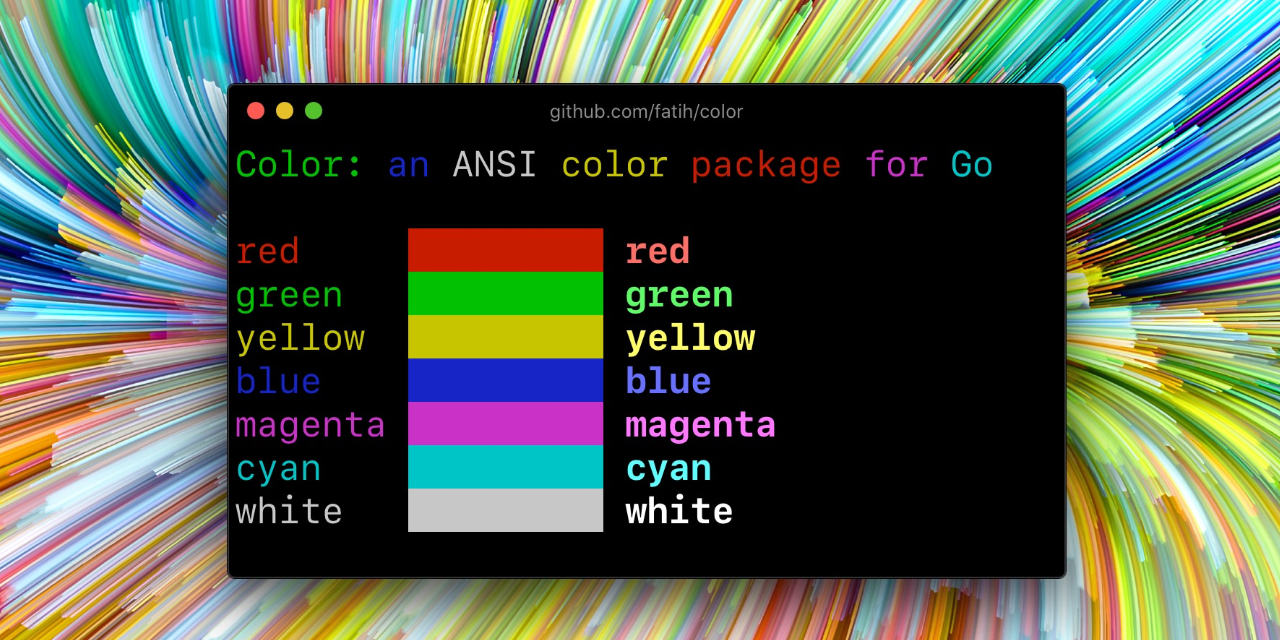color 

Color lets you use colorized outputs in terms of ANSI Escape
Codes in Go (Golang). It
has support for Windows too! The API can be used in several ways, pick one that
suits you.

Install
go get github.com/fatih/color
Examples
Standard colors
color.Cyan("Prints text in cyan.")
color.Blue("Prints %s in blue.", "text")
color.Red("We have red")
color.Magenta("And many others ..")
Mix and reuse colors
c := color.New(color.FgCyan).Add(color.Underline)
c.Println("Prints cyan text with an underline.")
d := color.New(color.FgCyan, color.Bold)
d.Printf("This prints bold cyan %s\n", "too!.")
red := color.New(color.FgRed)
boldRed := red.Add(color.Bold)
boldRed.Println("This will print text in bold red.")
whiteBackground := red.Add(color.BgWhite)
whiteBackground.Println("Red text with white background.")
Use your own output (io.Writer)
color.New(color.FgBlue).Fprintln(myWriter, "blue color!")
blue := color.New(color.FgBlue)
blue.Fprint(writer, "This will print text in blue.")
Custom print functions (PrintFunc)
red := color.New(color.FgRed).PrintfFunc()
red("Warning")
red("Error: %s", err)
notice := color.New(color.Bold, color.FgGreen).PrintlnFunc()
notice("Don't forget this...")
Custom fprint functions (FprintFunc)
blue := color.New(color.FgBlue).FprintfFunc()
blue(myWriter, "important notice: %s", stars)
success := color.New(color.Bold, color.FgGreen).FprintlnFunc()
success(myWriter, "Don't forget this...")
Insert into noncolor strings (SprintFunc)
yellow := color.New(color.FgYellow).SprintFunc()
red := color.New(color.FgRed).SprintFunc()
fmt.Printf("This is a %s and this is %s.\n", yellow("warning"), red("error"))
info := color.New(color.FgWhite, color.BgGreen).SprintFunc()
fmt.Printf("This %s rocks!\n", info("package"))
fmt.Println("This", color.RedString("warning"), "should be not neglected.")
fmt.Printf("%v %v\n", color.GreenString("Info:"), "an important message.")
fmt.Fprintf(color.Output, "Windows support: %s", color.GreenString("PASS"))
Plug into existing code
color.Set(color.FgYellow)
fmt.Println("Existing text will now be in yellow")
fmt.Printf("This one %s\n", "too")
color.Unset()
color.Set(color.FgMagenta, color.Bold)
defer color.Unset()
fmt.Println("All text will now be bold magenta.")
Disable/Enable color
There might be a case where you want to explicitly disable/enable color output. the
go-isatty package will automatically disable color output for non-tty output streams
(for example if the output were piped directly to less).
The color package also disables color output if the NO_COLOR environment
variable is set to a non-empty string.
Color has support to disable/enable colors programmatically both globally and
for single color definitions. For example suppose you have a CLI app and a
-no-color bool flag. You can easily disable the color output with:
var flagNoColor = flag.Bool("no-color", false, "Disable color output")
if *flagNoColor {
color.NoColor = true
}
It also has support for single color definitions (local). You can
disable/enable color output on the fly:
c := color.New(color.FgCyan)
c.Println("Prints cyan text")
c.DisableColor()
c.Println("This is printed without any color")
c.EnableColor()
c.Println("This prints again cyan...")
GitHub Actions
To output color in GitHub Actions (or other CI systems that support ANSI colors), make sure to set color.NoColor = false so that it bypasses the check for non-tty output streams.
Todo
- Save/Return previous values
- Evaluate fmt.Formatter interface
Credits
License
The MIT License (MIT) - see LICENSE.md for more details




